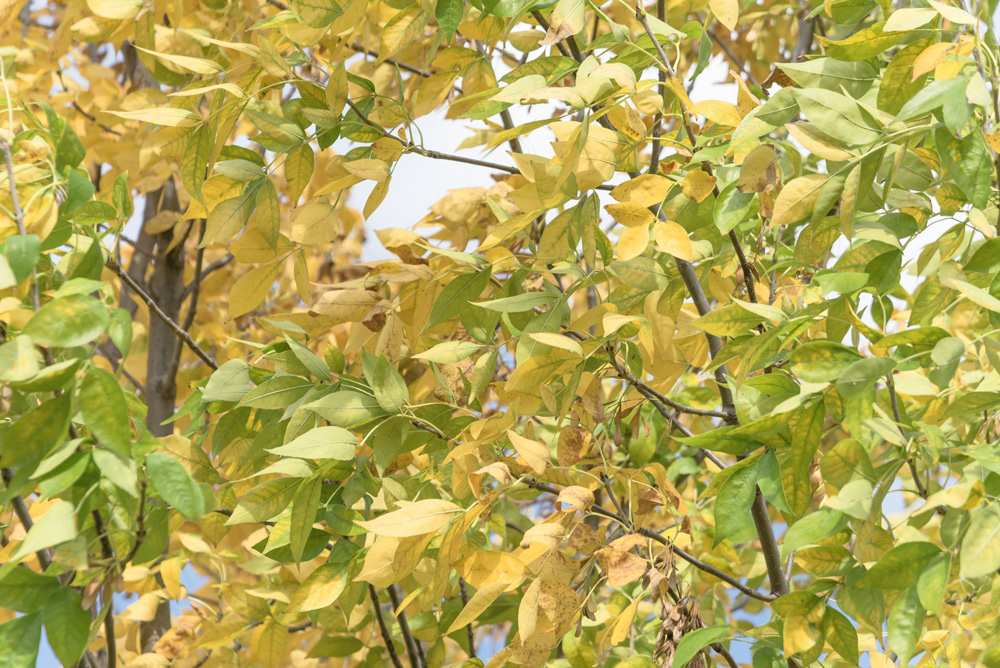Ulmus crassifolia
Common Name:
Cedar Elm

General Information:
Also called Scrub Elm, Lime Elm, Texas Elm, Basket Elm, Red Elm, and Southern Rock Elm, is often found in limestone soils in Texas, Oklahoma, Arkansas, and northern Louisiana. U. crassifolia in nature is a tree up to 90 feet tall, with slender, somewhat drooping branches and rounded crown. Twigs or branches often have lateral corky wings (but not so pronounced as the related species the Winged Elm Ulmus alata); crassifolia refers to the rough, sandpaper-like leaves. It is long-lived (over 50 yrs.); and has hard, dense wood, light in color with darker heart.
Leaves:
Simple, alternate, 2.5 – 5 cm long by 1.3 – 2 cm broad, elliptic to ovate, acute or obtuse at apex, rounded or cuneate to oblique at base, doubly serrate on margin; dark green, stiff, and very rough to the touch above, lighter in colour beneath. The leaves appear in early spring and turn yellow in fall.
Flowers:
Borne usually in July in small, 3 - 5 flowered fascicles; pedicels slender, 8 to 13 mm; calyx campanulate, hairy, red to green, 6 – 9 lobed, lobes hairy and acute; no petals; stamens 5 – 6, with slender filaments and reddish purple anthers; pistil green, flattened, pubescent, composed of a 2-celled ovary and 2 exserted spreading styles. Fruit: Samara borne in late summer, small, 8 to 10 mm long, oval-elliptic or oblong, green, flattened, pubescent; composed of a central seed surrounded by a wing which is deeply notched at apex and ciliate on margin.
Twigs:
Reddish brown, pubescent, often with brown, thin, lateral corky wings.
Bark:
Brown to reddish, but more often gray, ridges flattened and broken into thin, loose scales. The bark only forms on mature trunks, limbs and branches after a minimum of 5 yrs.
Rootage:
Normally found with pronounced taproot leading to fine hair-like root tips, but radial, lateral surface rootage is quite common where surface moisture is abundant. When taproot cut, prolifically grows new roots from edge of cut.
Lighting:
Prefers full sun.
Temperature:
Hardy to zone 6.
Bonsai:
The best specimens of U. crassifolia are usually collected from nature, especially if found growing in an environment where they have been kept low by browsing cattle, horses or native wildlife. However, they may be grown from seed, cutting or air layer, and will adapt to virtually any traditional bonsai style. U. crassifolia easily accepts thread grafts, but generally grafting is not necessary due to the abundance of new budding from the trunk of even mature trees. Pinching of new buds during the growing season will result in considerable leaf reduction.
Collecting:
One of the many advantages of U. crassifolia is its ease of collection in the field. It produces new fibrous roots easily, and can be bare-rooted at time of collection with little ill effect (providing that the roots are kept moist until replanted).
Wiring: Since bark does not form on new growth for several years, wiring of new limbs and branches poses no special problems. Limbs can be wired in the traditional wrap- around method, simply pulled with guy wires or moved with branch bending clamps. As with any deciduous tree, if wire is left in place too long it will make scars, however, unlike Maples it is very forgiving and small wiring scars will eventually be obscured by bark.
Pruning:
Pruning is the primary means of shaping U. crassifolia. Pruning and leaf trimming can be used to increase the ramification of twigs, to induce branches to grow where none grow now, and to create valuable open spaces. Major pruning is not a problem; a branch, once removed, is relatively easy to replace as U. crassifolia tends to sprout new buds prolifically at the site of pruned limbs. In the case of major branch removal, U. crassifolia will repair pruning scars quite well if the cut is made flush with the trunk.
U. crassifolia will endure leaf stripping (complete removal of leaves), but only if the plant is healthy in all respects. The new leaves will generally be smaller than those removed.
Repotting:
Potting and root pruning should be done in spring, as leaf buds swell. When mature, it is quite hardy and will suffer severe root pruning without ill effect. (However, do not strip leaves in the same year as the severe root pruning). Root pruning probably should be done every other year on a mature tree, but the amount of annual root growth will vary, depending on conditions, pot size, fertilization schedule, watering regime, and the individual tree. Younger trees and seedlings-in-training may be root pruned annually.
U. crassifolia grows naturally in a wide assortment of soils with a preference for alkaline clay soils and will survive in (and may even prefer) a heavier, more water- retaining soil than many trees. They will do quite well in a “normal” bonsai soil -- although in hot climates they may as a result require more frequent watering.
Dark, unglazed earth-tone pots are preferred. Shape--oval or rectangle, depending on the styling of the tree. Here, though, your own tastes are paramount.
Pests & Diseases:
Cedar elm will occasionally have insect pests, such as aphids, spider mites, cotton (aka “cushiony”) scale, and some minor elm leaf beetle damage. Small reddish-purple leaf galls can appear on some of the leaves in late spring to early summer caused by a species of wasp. Mildew in the late summer can occur when the leaves are exposed to too much moisture, but can be controlled to some degree with fungicides. Mistletoe will occasionally occur in trees that are under stress and in poor health.
Bibliography:
Howard Garrett Howard Garrett’s Texas Trees Robert A. Vines Trees of North Texas
Neil Sperry Complete Guide to Texas Gardening
Compiled by Michael E. Smoller
